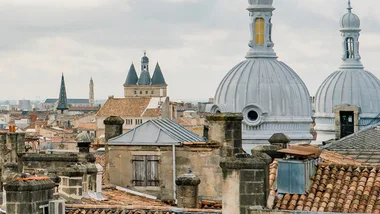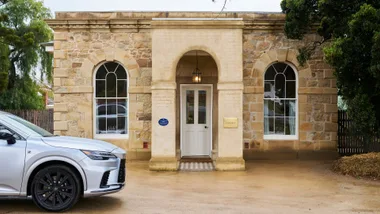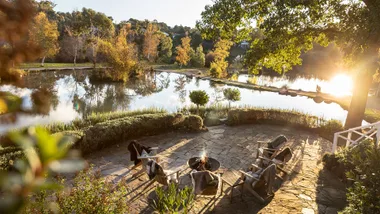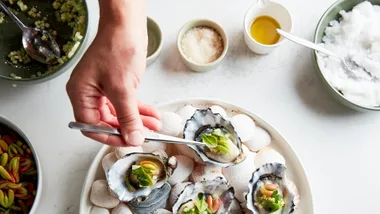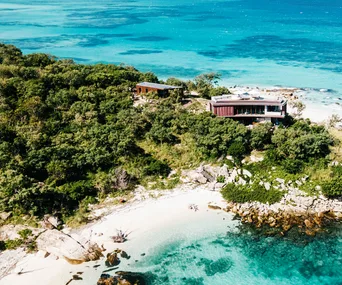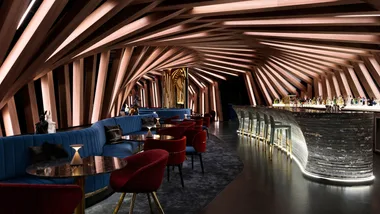THE FINE PRINT
**GETTING THERE
**Qantas flies from Sydney to Santiago, Chile, three times a week with onward connections to Lima and Cusco on codeshare partner LAN Chile.
The opulent Orient Express train takes travellers between Cusco and the foot of Machu Picchu. 1800 000 395
**STAY
** The following two Orient Express hotels can be booked from Australia on 1800 000 395.
The best place to stay in Miraflores. Ave Malecon de la Reserva 1035, Miraflores, Lima, +51 1 610 4000
The fastidious restoration of this former convent uncovered frescoes and Incan street architecture. It now boasts a Virgilio Martinez bistro, views of Cusco’s squares and the first outdoor pool in the city. Plaza Nazarenas 144, Cusco, +51 1 610 8300
**EAT
The place that sparked Gastón Acurio’s culinary empire, and progenitor of the novoandino style. Number 35 on the World’s 50 Best Restaurants list. Calle Cantuarias 175, Miraflores, Lima, +51 1 242 5387
La Canta Rana
This huarique in the seaside suburb of Barranco is one of the best places in Lima to have lunch. Genova 101, Barranco, Lima, +51 1 247 7274
Virgilio Martinez’s stylish exploration of fusion techniques and rare ingredients is nipping at Acurio’s heels. Calle Santa Isabel 376, Miraflores, Lima, +51 1 242 8575
**Huayoccari Hacienda Restaurant
** This estate is a private home, but also offers a small number of guests Peruvian country cooking in a majestic property crammed with Incan artefacts and Cusco school paintings. Carretera Cusco-Urubamba, Km 64, +51 84 962 2224
Another Gastón Acurio enterprise: home-style classics are rarely better expressed. Joy Square 261, Cusco, +51 84 240520
Gastón Acurio’s cevicheria on a street dedicated to them. Av La Mar 770, Miraflores, Lima, +51 1 421 3365
A classic cevicheria serving tapas and sanguches too. Arias Araguez 698, Miraflores, Lima, +51 1 445 5180
Like the chef after which it’s named: casual, eccentric, but driven by attention to detail. San Martin 300, Miraflores, Lima, +51 1 242 4149
A cevicheria run by a fisherman who presents the freshest of his catch. Augustin Lozano La Rosa, 173 Chorrillos, Lima, +51 1 249 6850
**FURTHER INFORMATION
Why has Peruvian food not taken off more in Australia? In the rest of the world its rise has been stratospheric; here it hasn’t even made it to the launch platform. New York has seen its Peruvian restaurants increase fourfold in five years, while we fool around with Mexican and Brazilian. Ceviche merchants and purveyors of novoandino dot Buenos Aires and are gaining a foothold in London, but as yet are next to nowhere on these shores. Gastón Acurio runs 32 restaurants in 12 cities. Sydney and Melbourne are not among them. But here, in Lima, a city that rambles down the Pacific coast and wakes up to a haze and surfers in its cold currents, I sense good news. We can be forgiven for being late on Peruvian food: we have an excuse. The Peruvians were late as well. They have only just discovered gastronomy, including their own. They have only just discovered surfing as well, but they now compete with the world at that too.
From this city, the turnstile between the Pacific, the Amazon and the Andes, it’s surprising it took so long. Peruvian food is already a fusion cuisine in the wild. Take ceviche, the national dish (or at least the national dish that gets exported; roast guinea pig remains a domestic taste). It’s an Incan-Spanish-Moorish food, perfected by Japanese immigrants who marinated the fish quickly instead of letting it wallow in key lime. It’s a lunch food here, refreshing and acidic, often served in shells heaped with onion and chilli at long counters. It so heavily permeates the Peruvian palate that the marinade is enjoyed as a drink by itself, leche de tigre, or the milk of the tiger. This mix of citrus, garlic, onion and fish juice is feted as both aphrodisiac and hangover cure, but is howlingly improbable as either. I try a fortified rendition known as leche de pantera, the milk of the panther, spiked with a handful of black scallops, in a legendary football-scarf-draped cevicheria called La Canta Rana.
La Canta Rana is one of Lima’s huariques, small places dedicated to traditional food served authentically and inexpensively – it has its own cult following. There are also tiny set-menu lunch restaurants, known as menus, often run from someone’s home with the TV set on; sangucherías, which serve tapas-style bocadillos (rolls) thick with cured ham, fried white anchovies, or the lardaceous fried pork called chicharrónes, a favourite breakfast food and a more likely hangover cure than leche de tigre. There are chifas, specialising in Chinese-Peruvian meals; and anticucherias, Afro-Peruvian street vendors selling grilled seasoned beef heart on skewers; good Italian; and some of the best sushi outside Japan. That’s before we get to the more refined novoandino outfits, increasingly found on lists of the world’s best restaurants. Chileans, traditionally national rivals who looked down on what they considered their benighted neighbour, have started making weekend trips to Lima just to eat.
Underneath the stream of immigrants responsible for bringing all these influences, history here followed the familiar Latin American pattern: a conquistador class ignoring the indigenous culture where it could, and stamping it down where it couldn’t. But in Peru, the Incan presence was too pervasive to be dealt with by repression alone. Delusion was required too. Old-town Lima is built from the breathtaking grandeur of delusion, a colonial cocktail of half-forgotten European capitals, jammed with boulevards that crudely connect colonnade-lined squares full of statues rendered in marble and high camp. There are golf-green lawns set in parks where it last rained in 1970, and at the centre of a spider’s web of intersections, a towering winged Victory, a self-awarded consolation prize for Peru’s humiliating defeat in the Chincha Islands War, or the Guano War. This is a place that can flamboyantly monumentalise anything, even a straight-sets loss in a squalid armed spat over bird poo.
The buildings are often centuries more recent than they look, as Limeños were still in the business of building jumbo neo-classical follies when almost everyone else had moved on. The Palace of Justice, as imposing as a bouncer and built in inverse proportion to the quantity of justice it dispensed, wasn’t finished until 1938. The immensity of all this propaganda in stone makes sense when you realise it all had to be built bigger than the hundreds of Incan and pre-Incan sacred sites dotting the city. We visit the Huaca Pucllana, an adobe mud-brick complex mounding out of the finance-worker-hive suburb of Miraflores. It’s a startling place, as startling as finding Giza in Moonee Ponds, but it’s also somewhere that helps make sense of Peru’s belated discovery of its own cuisine. From Pucllana’s zenith, you can look out and still see what’s left of a wall of indifference, the crumbling, centuries-old prejudices of the temple’s neighbours. Write off one of the world’s great archaeological and architectural achievements as an embarrassingly ethnic pile of bricks, and ignoring a culinary legacy on the same scale is easy.
Miraflores is where Gastón Acurio opened his first restaurant, Astrid y Gastón, back when he was just Gastón Acurio, chef, instead of Gastón, the most famous person in Peru. He’s more than just a celebrity chef, he’s Peruvian cuisine’s liberator and evangelist, someone seriously discussed as a possible presidential candidate. Ferran Adrià has just co-made a documentary about Peruvian food with him. Peru Sabe: Cuisine as an Agent of Social Change had its US premiere at the United Nations headquarters in New York. The title might seem presumptuous, even pretentious after the colon, but the reality meets the billing. You can ask anyone. In Cusco, the old Incan capital at the foot of the Andes, I meet Virgilio Martinez, a feted young restaurateur and chef who has opened a svelte Peruvian bistro called Senzo in the Palacio Nazarenas, a new Orient Express hotel set in a freshly renovated centuries-old convent, complete with its own herb garden. Martinez is a former Acurio protégé, and I ask him the most important thing he learned. He says it was quite simple. “He taught me to respect my country.”
Martinez can still remember when the only fine restaurants in Lima were ersatz French or Italian joints, how embarrassed he felt when his mother served Peruvian food to his friends, and the period during the Maoist Shining Path insurgency when Cusco was too dangerous to visit, when he and anyone else with the means left the country. “We were ashamed of being Peruvian overseas,” he says. “We were educated with the belief that our nation was very poor, with not much to offer. But then, when I was working in London in a restaurant, I started hearing all these things about our food, so I went back to Lima to see for myself. I’d only been there for one day when I decided to stay.” It took barely a decade for Martinez to go from being iffy about serving Peruvian food in his own home to serving it in two of his own restaurants, with a third, named Lima, just opened in London.
Martinez’s trajectory would have been impossible without Acurio. Twenty years ago, it was unheard of for a respectable person in Peru to become a chef. Acurio learnt his craft in cooking schools in Spain and France, hiding his ambition from his politician father (who would have given it a level of respect one notch above becoming a circus performer) before applying the techniques to what he knew from home. Now more than 80,000 Peruvians are enrolled in cooking schools. “Here the young don’t want to be footballers, they want to be chefs,” Adrià said with admiration following his visit.
What hit Martinez on his first day back in Lima was the richness of the street-food culture, the variety of produce in the markets, and how the finer restaurants were applying culinary techniques to produce the energetic novoandino. “The anticucherias, the street vendors… I had seen things like that in South East Asia, but I had no idea they existed in my own country.”
The market alone was almost enough to keep him in Peru. “The range of organic products here is unbelievable. Limitless. I’ve used 59 different types of potato, but there are about 3000 more.” The divisions between coast, jungle and mountains made things simmer politically, but in a Peruvian market they result in a boundless larder, the bounty of 28 different climates. Just the fruit is enough to keep a chef preoccupied: fervently flavoured bananas, the finest mangoes, tart thin-skinned limónes juiced for ceviches and Pisco Sours, larger cousins of the passionfruit called granadillas, full of subtly sweet aromatic seeds, custard apples and mandarins. There are the bright, fragrant aji chillies, the keystone Peruvian flavour.
Here you’ll find folk healers with sheafs of Amazonian herbs, preparations of jungle medicine “for energy”, featuring a woman with a pornographic pout on the label, preparations of jungle medicine for constipation, featuring a woman with a pornographic pout on the label, and bags of coca leaves for tea. At the stall next door, an old Andean woman opens a small bucket and shows us a nest of squirming grubs sharing their quarters with a melon-sized snail. There are sacks of quinoa, bags of small purple corn for boiling with pineapple rind and cinnamon and turning into a sweet drink known as chicha morada, and piles of huge yellow chulpe corn for eating, with kernels the dimensions of a thumb.
Outside Cusco, through fog so thick and sudden that we assume there’s been a fire, we drive into the farming lands of Maras and Moray, the source of so much of this produce, where the chulpe is being harvested. We pass fields of broad beans fenced with blue agave, along roads intermittently blocked with donkeys hauling loads of tarnished golden husks. In the village, women in coloured woven shawls and high-crowned white hats are working in the sun, skinning cobs with sharp sticks. The work is fuelled by chicha, a nourishing maize beer drunk out of amphorae and tin cups. It’s brewed in a clay-coloured house advertising its wares with a stick covered in coloured plastic bags. And we’re invited inside, where a pink-faced, wheezing woman stirs an iron cauldron over a fire while a couple of guinea pigs shadow-box on the dirt floor, practising fending off cooks. Life here hasn’t much changed in 300 years; the only signs of modernity are a painted truck full of felled eucalypts, a doctor (closed today), and speakers playing thin, mournful huayno music through the yards. It’s as far from salsa as the blues.
Quechua, the language of the Incas, is the dialect of these hospitable but circumspect people, but many of the original place names have been forgotten and replaced – the saddle-backed sacred mountain high on the horizon, rising barren and brown over the umber fields, is now called Veronica.
Before I came to Peru, my impression of the Incas was of an occult people shrouded in the mists of time, building huge monuments in difficult places for reasons so mysterious that speculation ran all the way to UFOs. But when I see their work in person, awestruck, they seem more like Germans in condor feathers, consummate engineers and administrators, with their sun-worship a form of farming almanac that raised agriculture to the level of art. At Moray there is a stadium-sized set of concentric stone terraces sunk into a natural depression in the hills, a place once believed to be an amphitheatre. In fact it was probably a kind of food lab, a structure that created a microclimate where crops could be grown far above their favoured elevations, as in a glassless, upside-down greenhouse. We climb it, tipsy and ragged with the altitude, pausing for breath and to take in its sculptural, emphatic refinement.
Ancient Incan terraces line the Sacred Valley as well, the canyon formed by the dark jade flow of the Urabumba river. We trace its current in the Hiram Bingham train between Cusco and Machu Picchu, watching the landscape change from the crop plains of Maras to mountains with verdigris-stained stone feet and clouded peaks, before the ranges peel away into jungle. En route the Bingham pulls up beside a more humble and more crowded Peruvian train, and over the brass table lamps I feel a small twinge of Western guilt. But it turns out these people are tourists as well, not commuting workers, and are headed to the same place we are. The domestic appetite for travel, especially comfortable travel, is growing, and in the past few years foreigners and Peruvians have together mounted Machu Picchu in such numbers that the government has had to cap visitor permits in order to stop the place crumbling to bits.
There are tripping hippies striking yoga poses in line with the axis of solstice, Japanese students dressed as Andean peasants, autodidacts giving personalised, factually incorrect tours of the temples as their lagging spouses perform one of the great wanders of the world. There’s an awesome quantity of wilderness paraphernalia, seemingly able-bodied people with golden graphite poles, knee-bags and hydration systems, wind-chill-factored jackets and Gore-tex gaiters, bracing themselves to climb a brief hill. (On stairs. With a guide.) Together they swarm, clack and shuffle uncomfortably against the walls of the Temple of the Sun.
The true purpose of the buildings at Machu Picchu is still unknown, but odds-on it was a residential complex, a kind of gated community for Incan aristocracy complete with history’s best landscape feature garden, all built, inhabited and abandoned within less than a century. Climb the stone steps higher and the crowds are dwarfed and quiet. There is a lone kestrel, catching a current far above the vertiginous valley. It must have been this silent when a young local boy who had been using it as his playground first showed it to Hiram Bingham. From up here, the people look welcome – Peruvians and their guests embracing the place in a process of perpetual rediscovery.
 john laurie
john laurie
